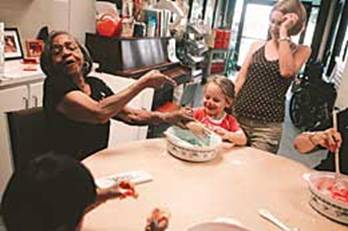|
Program
Lets Kids, Elders Share Lessons:
Virginia Tech is Studying How Children and Elderly People Interact with
One Another.
By Greg Esposito, The Roanoke Times
August
5, 2008

Justin Cook, The Roanoke Times - Joan Sills holds the hand of Zoe Zimmerman, 3, during a closing song during a Neighbors Growing Together session, a program developed by Virginia Tech's department of human development about eight years ago. Elders in Tech's Adult Day Services mingle with children in the university's neighboring Child Development Center for Learning and Research for about 20 minutes three mornings a week.
There were lessons to be learned all around at the intergenerational workshop at Virginia Tech last Tuesday.
Joan Sills, 77, taught her partner, 3-year-old Zoe Zimmerman, that too much salt is bad for you.
Zoe informed Sills that she was, in fact, a kitty cat.
And "kitty cats sing with their tongues out," explained Zoe, whiskers painted on her face.
Sills and Zoe were two of six people who took part in the activity that morning as part of Neighbors Growing Together, a program developed by Tech's department of human development about eight years ago. Elders in Tech's Adult Day Services mingle with children in the university's neighboring Child Development Center for Learning and Research for about 20 minutes three mornings a week. The sessions usually involve crafts activities such as painting or making a substance similar to Play-Doh.
Program director and interim human development department head Shannon Jarrott thinks there are larger lessons to be learned from observing the interactions between the children, who range from 14 months to 5 years old, and elders, many with cognitive difficulties.

Justin Cook, The Roanoke Times - Joan Sills (left) jokingly scolds Zoe Zimmerman, 3, for throwing Play-Doh at her as Ashley Heffron looks on in Wallace Hall at Virgina Tech. Sills and Zoe were participating in Neighbors Growing Together, a program developed by Tech’s department of human development about eight years ago.
For the adults, it gives them a chance to care for others when most of their time is spent receiving care.
"Here someone is asking them to take on a role and be a nurturer and a teacher," Jarrott said. "It's really valuable for their self-esteem and sense of self."
For the children, it teaches them how to cooperate with others and improves their perception of what it means to be old, she said. Studies have shown the effects of intergenerational programs show up in elementary school students' empathy and attitude toward older people.
"They learn that having wrinkles or using a walker or a wheelchair doesn't mean that you're scary or can't be touched," Jarrott said.
A new class of children is scheduled to join the program in mid-August, and Ashley Heffron, a teacher with the child development center, said the difference in the children's attitudes toward the elders as the year progresses is obvious.
At first some children are afraid to even be in the common room, which has a door that opens up into the adult day services area.
"Now when they make a project, it's, 'We want to show the neighbors.' " she said.
Changing youngsters' attitudes about older adults is becoming increasingly important, Jarrott said, because the elderly population is growing and the number of people interested in working with seniors is declining.
There are 100 to 125 intergenerational programs such as Neighbors Growing Together nationwide, Jarrott said. But only one other university in the country has a program similar to Tech's -- the Medical College of Virginia in Richmond started one last year but is not conducting research on the interaction between children and elders, Jarrott said.
She was in Charlottesville last week giving a presentation to people interested in starting a similar program there.
"It isn't just a case of putting kids and old people in the same room and hoping for magic to happen," she said.
That's why the sessions, held in the common area between the child development and adult day services areas, are limited to about 20 minutes and a few children and a few elderly people. Julie Leventhal, a Ph.D. student who is coordinating the intergenerational program this summer, and Heffron were very active during last Tuesday's session.
They split the six into three intergenerational teams to make the dough, encouraging them to work together, helping them mix their flour, salt and water and watching out for excessive silliness.
Zoe was having a little too much fun throwing flour at her partner, and Heffron had to pull her aside for a quick talking to. She rejoined the group and played nicely for the final few minutes.
After Heffron walked the children out of the common area, the adults joked about how exhausted and messy the children left them.
"You mean I can take a nap now?" said Ray Keller, an 86-year-old from Blacksburg who entered the common area with the help of a walker.
Sills, despite the flour attack, was all laughs and smiles.
"I think they're sweethearts," she said. "I like the little people. They're used to us by now."
More Information on US Elder Rights Issues
Copyright © Global Action on Aging
Terms of Use |
Privacy Policy | Contact
Us
|



